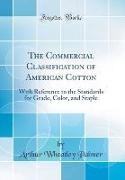- Start
- The Commercial Classification of American Cotton
The Commercial Classification of American Cotton
Angebote / Angebote:
Excerpt from The Commercial Classification of American Cotton: With Reference to the Standards for Grade, Color, and StapleIn the field of financing it also plays a part. Cotton factors and commission merchants have long been accustomed to appraise cotton for loans and advances according to its classification. Commercial bankers, on the contrary, have not until recently given close atten tion to this phase of their loan collateral, although to ascertain very nearly the market value of a bale of cotton of which the weight and classification are known is, in most cases, a simple matter. Banks have found difficulty in securing classification data from a disinterested source, and with the purpose in part of meeting this condition, the United States warehouse act was passed in 1916. According to its provisions a warehouse, properly examined, bonded, and licensed, may issue a receipt bearing on its face a notation of the grade and staple of each bale represented and for this classifi cation the warehousemen stand responsible to the holder of the re ceipt. Needless to say bankers generally have to recognize the adyah tage of such a receipt, and their interest in cotton classification has been correspondingly stimulated.The Spinning value'of cotton can be expressed, to a certain extent, in terms of grade and staple length. The longer staples and better grades are, as a rule, used in the production of the finer and stronger yarns and'the finer fabrics. The higher grades contain less waste and usually give more satisfactory results in the bleaching and dy ing processes. Generally speaking, the longer staples go into yarns of greater strength and of higher count or of finer size. There is, however, in addition to grade and staple, another important element in spinning value known as character. By character is meant the strength, body, uniformity, and smoothness of the fibers. The term is sometimes loosely employed in the cotton trade to denote color or kind of cotton, but in this circular it will be used only in its more exact sense.For convenience of arrangement, the subjects of grade, staple, and character are separately considered. Since the upland varieties con stitute all but a small fraction of the American crop, the discussion relates particularly to upland cotton, as distinguished from Ameri can Egyptian and sea-island cottons. The principles, nevertheless, that govern in the classification of upland cotton apply equally to cotton of any growth, and in treating the classification of the Ameri can Egyptian and sea-island varieties it is only necessary to point out in one or two paragraphs certain of their special characteristics which are different from those of the upland varieties.About the PublisherForgotten Books publishes hundreds of thousands of rare and classic books. Find more at www.forgottenbooks.comThis book is a reproduction of an important historical work. Forgotten Books uses state-of-the-art technology to digitally reconstruct the work, preserving the original format whilst repairing imperfections present in the aged copy. In rare cases, an imperfection in the original, such as a blemish or missing page, may be replicated in our edition. We do, however, repair the vast majority of imperfections successfully, any imperfections that remain are intentionally left to preserve the state of such historical works.
Folgt in ca. 10 Arbeitstagen
